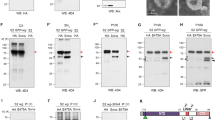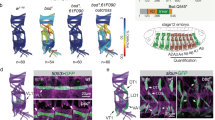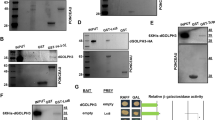Abstract
Mammalian Vav signal transducer proteins couple receptor tyrosine kinase signals to the activation of the Rho/Rac GTPases, leading to cell differentiation and/or proliferation. The unique and complex structure of mammalian Vav proteins is preserved in the Drosophila melanogaster homologue, DroVav. We demonstrate that DroVav functions as a guanine-nucleotide exchange factor (GEF) for DRac. Drosophila cells overexpressing wild-type (wt) DroVav exhibited a normal morphology. However, overexpression of a truncated DroVav mutant (that functions as an oncogene when expressed in NIH3T3 cells) results in striking changes in the actin cytoskeleton, resembling those usually visible following Rac activation. Dominant-negative DRac abrogated these morphological changes, suggesting that the effect of the truncated DroVav mutant is mediated by activation of DRac. In Drosophila cells, we find that stimulation of the Drosophila EGF receptor (DER) increases tyrosine phosphorylation of DroVav, which in turn associates with tyrosine-phosphorylated DER. In addition, the following results imply that DroVav participates in downstream DER signalling, such as ERK phosphorylation: (a) overexpression of DroVav induces ERK phosphorylation; and (b) ‘knockout’ of DroVav by RNA interference blocks ERK phosphorylation induced by DER stimulation. Unlike mammalian Vav proteins, DroVav was not found to induce Jnk phosphorylation under the experimental circumstances tested in fly cells. These results establish the role of DroVav as a signal transducer that participates in receptor tyrosine kinase pathways and functions as a GEF for the small RhoGTPase, DRac.
This is a preview of subscription content, access via your institution
Access options
Subscribe to this journal
Receive 50 print issues and online access
$259.00 per year
only $5.18 per issue
Buy this article
- Purchase on Springer Link
- Instant access to full article PDF
Prices may be subject to local taxes which are calculated during checkout






Similar content being viewed by others
References
Bar-Sagi D and Hall A . (2000). Cell, 103, 227–238.
Bourbon HM, Gonzy-Treboul G, Peronnet F, Alin MF, Ardourel C, Benassayag C, Cribbs D, Deutsch J, Ferrer P, Haenlin M, Lepesant JA, Noselli S and Vincent A . (2000). Mech. Dev., 110, 71–83.
Bustelo XR, Ledbetter JA and Barbacid M . (1992). Nature, 356, 69–71.
Bustelo XR, Suen KL, Leftheris K, Meyers CA and Barbacid M . (1994). Oncogene, 9, 2405–2413.
Bustelo XR . (2000). Mol. Cell. Biol., 20, 1461–1477.
Cao Y, Janssen EM, Duncan AW, Altman A, Billadeau DD and Abraham RT . (2002). EMBO J., 21, 4809–4819.
Carthew RW . (2001). Curr. Opin. Cell. Biol., 13, 244–248.
Chen W, White MA and Cobb MH . (2002). J. Biol. Chem., 277, 49105–49110.
Clemens JC, Worby CA, Simonson-Leff N, Muda M, Maehama T, Hemmings BA and Dixon JE . (2000). Proc. Natl. Acad. Sci. USA, 97, 6499–6503.
Coppola MS, Bryant S, Koda T, Conway D and Barbacid M . (1991). Cell Growth Differ., 2, 95–105.
Costello PS, Walters AE, Mee PJ, Turner M, Reynolds LF, Prisco A, Sarner N, Zamoyska R and Tybulewicz VL . (1999). Proc. Natl. Acad. Sci. USA, 96, 3035–3040.
Crespo P, Bustelo XR, Aaronson DS, Coso OA, Lopez-Barahona M, Barbacid M and Gutkind JS . (1996). Oncogene, 13, 455–460.
Crespo P, Schuebel KE, Ostrom AA, Gutkind JS and Bustelo XR . (1997). Nature, 385, 169–172.
Dekel I, Russek N, Jones T, Mortin MA and Katzav S . (2000). FEBS Lett., 472, 99–104.
Del Pozo MA, Schwartz MA, Hu J, Kiosses WB, Altman A and Villalba M . (2003). J. Immunol., 170, 41–47.
Doody GM, Bell SE, Vigorito E, Clayton E, McAdam S, Tooze R, Fernandez C, Lee IJ and Turner M . (2001). Nat. Immunol., 2, 542–547.
Ebinu JO, Bottorff DA, Chan EY, Stang SL, Dunn RJ and Stone JC . (1998). Science, 280, 1082–1086.
Fanger GR, Johnson NL and Johnson GL . (1997). EMBO J., 16, 4961–4972.
Fischer KD, Kong YY, Nishina H, Tedford K, Marengere LE, Kozieradzki I, Sasaki T, Starr M, Chan G, Gardener S, Nghiem MP, Bouchard D, Barbacid M, Bernstein A and Penninger JM . (1998). Curr. Biol., 8, 554–562.
Golembo M, Schweitzer R, Freeman M and Shilo BZ . (1996). Development, 122, 223–230.
Golembo M, Yarnitzky T, Volk T and Shilo BZ . (1999). Genes Dev., 13, 158–162.
Groysman M, Hornstein I, Alcover C and Katzav S . (2003). J. Biol. Chem., 277, 50121–50130.
Hehner SP, Hofmann TG, Dienz O, Droge W and Schmitz ML . (2000). J. Biol. Chem., 275, 18160–18171.
Holsinger LJ, Graef IA, Swat W, Chi T, Bautista DM, Davidson L, Lewis RS, Alt FW and Crabtree GR . (1998). Curr. Biol., 8, 563–572.
Hornstein I, Alcover A and Katzav S . (2003). Cell. Signal. in press.
Hou XS, Goldstein ES and Perrimon N . (1997). Genes Dev., 11, 1728–1737.
Houlard M, Arudchandran R, Regnier-Ricard F, Germani A, Gisselbrecht S, Blank U, Rivera J and Varin-Blank N . (2002). J. Exp. Med., 195, 1115–1127.
Johmura S, Oh-hora M, Inabe K, Nishikawa Y, Hayashi K, Vigorito E, Kitamura D, Turner M, Shingu K, Hikida M and Kurosaki T . (2003). Immunity, 18, 777–787.
Jordan MS, Singer AL and Koretzky GA . (2003). Nat. Immunol., 4, 110–116.
Kaminuma O, Deckert M, Elly C, Liu YC and Altman A . (2001). Mol. Cell. Biol., 21, 3126–3136.
Katzav S . (1993). Oncogene, 8, 1757–1763.
Katzav S, Cleveland JL, Heslop HE and Pulido D . (1991). Mol. Cell. Biol., 11, 1912–1920.
Katzav S, Martin-Zanca D and Barbacid M . (1989). EMBO J., 8, 2283–2290.
Katzav S, Packham G, Sutherland M, Aroca P, Santos E and Cleveland JL . (1995). Oncogene, 11, 1079–1088.
Khosravi-Far R, Chrzanowska-Wodnicka M, Solski PA, Eva A, Burridge K and Der CJ . (1994). Mol. Cell. Biol., 14, 6848–6857.
Khune MR, Ku G and Weiss A . (2000). J. Biol. Chem., 275, 2185–2190.
Kranewitter WJ and Gimona M . (1999). FEBS Lett., 455, 123–129.
Lee IS, Liu Y, Narazaki M, Hibi M, Kishimoto T and Taga T . (1997). FEBS Lett., 401, 33–37.
Li W, Chong H and Guan KL . (2001). J. Biol. Chem., 276, 34728–34737.
Lorenzo PS, Beheshti M, Pettit GR, Stone JC and Blumberg PM . (2000). Mol. Pharmacol., 57, 840–846.
Luschnig S, Krauss J, Bohmann K, Desjeux I and Nusslein-Volhard C . (2000). Mol. Cell., 5, 231–241.
Ma AD, Metjian A, Bagrodia S, Taylor S and Abrams CS . (1998). Mol. Cell. Biol., 18, 4744–4751.
Manser E, Loo TH, Koh CG, Zhao ZS, Chen XQ, Tan L, Tan I, Leung T and Lim L . (1998). Mol. Cell., 1, 183–192.
Margolis B, Hu P, Katzav S, Li W, Oliver JM, Ulrich A, Weiss A and Schlessinger J . (1992). Nature, 356, 71–74.
Michel F, Mangino G, Attal-Bonnefoy G, Tuosto L, Alcover A, Roumier A, Olive D and Acuto O . (2000). J. Immunol., 165, 3820–3829.
Miranti CK, Leng L, Maschberger P, Brugge JS and Shattil SJ . (1998). Curr. Biol., 8, 1289–1299.
Moller A, Dienz O, Hehner SP, Droge W and Schmitz ML . (2001). J. Biol. Chem., 276, 20022–20028.
Movilla N and Bustelo XR . (1999). Mol. Cell. Biol., 19, 7870–7885.
Noselli S and Agnes F . (1999). Curr. Opin. Genet. Dev., 9, 466–472.
Pandey A, Podtelejnikov AV, Blagoev B, Bustelo XR, Mann M and Lodish HF . (2000). Proc. Natl. Acad. Sci. USA, 97, 179–184.
Perrimon N and Perkins LA . (1997). Cell, 89, 13–16.
Ramos-Morales F, Druker BJ and Fischer S . (1994). Oncogene, 9, 1917–1923.
Rebay I . (2002). Dev. Biol., 251, 1–17.
Reynolds LF, Smyth LA, Norton T, Freshney N, Downward J, Kioussis D and Tybulewicz VL . (2002). J. Exp. Med., 195, 1103–1114.
Ridley AJ and Hall A . (1992). Cell, 70, 389–399.
Riesgo-Escovar JR and Hafen E . (1997). Genes Dev., 11, 1717–1727.
Rivera J, Arudchandran R, Gonzalez-Espinosa C, Manetz TS and Xirasagar SA . (2001). Int. Arch. Allergy Immunol., 124, 137–141.
Roumier A, Olivo-Marin JC, Arpin M, Michel F, Martin M, Mangeat P, Acuto O, Dautry-Varsat A and Alcover A . (2001). Immunity, 15, 715–728.
Schlessinger J . (2000). Cell, 103, 211–225.
Schuebel KE, Bustelo XR, Nielsen DA, Song BJ, Barbacid M, Goldman D and Lee IJ . (1996). Oncogene, 13, 363–371.
Schweitzer R, Shaharabany M, Seger R and Shilo BZ . (1995). Genes Dev., 9, 1518–1529.
Schweitzer R and Shilo BZ . (1997). Trends Genet., 13, 191–196.
Settleman J . (2001). Dev. Cell., 1, 321–331.
Sluss HK, Han Z, Barrett T, Davis RJ and Ip YT . (1996). Genes Dev., 10, 2745–2758.
Sotillos S and Campuzano S . (2000). Development, 127, 5427–5438.
Tamas P, Solti Z, Bauer P, Illes A, Sipeki S, Bauer A, Farage A, Downward J and Buday L . (2003). J. Biol. Chem., 278, 5163–5171.
Tamas P, Solti Z and Buday L . (2001). Cell. Signal., 13, 475–481.
Tedford K, Nitschke L, Girkontaite I, Charlesworth A, Chan G, Sakk V, Barbacid M and Fischer KD . (2001). Nat. Immunol., 2, 548–555.
Therrien M, Wong AM, Kwan E and Rubin GM . (1999). Proc. Natl. Acad. Sci. USA, 96, 13259–13263.
Turner M and Billadeau DD . (2002). Nat. Rev. Immunol., 2, 476–486.
Villalba M, Hernandez J, Deckert M, Tanaka Y and Altman A . (2000). Eur. J. Immunol., 30, 1587–1596.
Wassarman DA, Therrien M and Rubin GM . (1995). Curr. Opin. Genet. Dev., 5, 44–50.
Wu J, Katzav S and Weiss A . (1995). Mol. Cell. Biol., 15, 4337–4346.
Zang M, Hayne C and Luo Z . (2002). J. Biol. Chem., 277, 4395–4405.
Zeng L, Sachdev P, Yan L, Chan JL, Trenkle T, McClelland M, Welsh J and Wang LH . (2000). Mol. Cell. Biol., 20, 9212–9224.
Acknowledgements
We thank Dr M Tarshish and Dr A Alcover for assistance with the confocal microscopy and to Professor B Shilo and Dr N Harden and Dr M Therrien for providing us with reagents. MAM is supported by the NIH intramural program. This work was supported by grants from the Israel Academy of Sciences and the Israel Cancer Association (SK).
Author information
Authors and Affiliations
Corresponding author
Rights and permissions
About this article
Cite this article
Hornstein, I., Mortin, M. & Katzav, S. DroVav, the Drosophila melanogaster homologue of the mammalian Vav proteins, serves as a signal transducer protein in the Rac and DER pathways. Oncogene 22, 6774–6784 (2003). https://doi.org/10.1038/sj.onc.1207027
Received:
Revised:
Accepted:
Published:
Issue Date:
DOI: https://doi.org/10.1038/sj.onc.1207027
Keywords
This article is cited by
-
Group choreography: mechanisms orchestrating the collective movement of border cells
Nature Reviews Molecular Cell Biology (2012)
-
Dynein light chain 1 functions in somatic cyst cells regulate spermatogonial divisions in Drosophila
Scientific Reports (2011)
-
An active form of Vav1 induces migration of mammary epithelial cells by stimulating secretion of an epidermal growth factor receptor ligand
Cell Communication and Signaling (2006)



